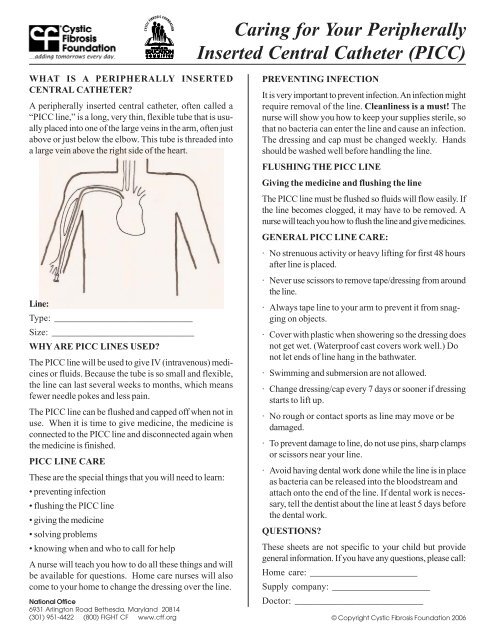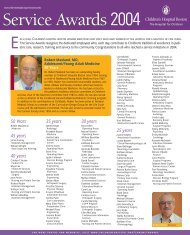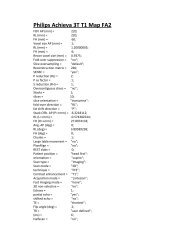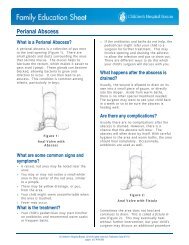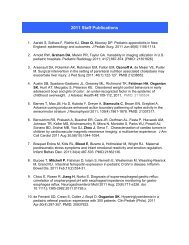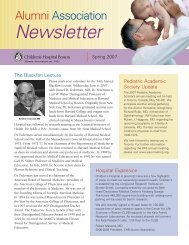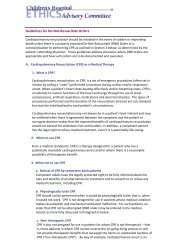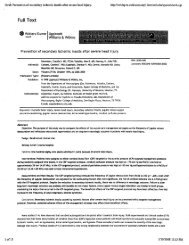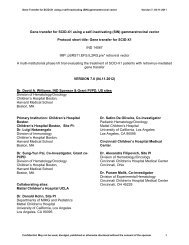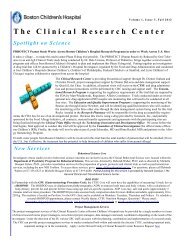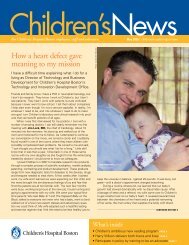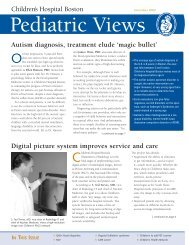Caring for Your Peripherally Inserted Central Catheter (PICC)
Caring for Your Peripherally Inserted Central Catheter (PICC)
Caring for Your Peripherally Inserted Central Catheter (PICC)
Create successful ePaper yourself
Turn your PDF publications into a flip-book with our unique Google optimized e-Paper software.
WHAT IS A PERIPHERALLY INSERTED<br />
CENTRAL CATHETER?<br />
A peripherally inserted central catheter, often called a<br />
“<strong>PICC</strong> line,” is a long, very thin, flexible tube that is usually<br />
placed into one of the large veins in the arm, often just<br />
above or just below the elbow. This tube is threaded into<br />
a large vein above the right side of the heart.<br />
Line:<br />
Type: _____________________________<br />
Size: ______________________________<br />
WHY ARE <strong>PICC</strong> LINES USED?<br />
The <strong>PICC</strong> line will be used to give IV (intravenous) medicines<br />
or fluids. Because the tube is so small and flexible,<br />
the line can last several weeks to months, which means<br />
fewer needle pokes and less pain.<br />
The <strong>PICC</strong> line can be flushed and capped off when not in<br />
use. When it is time to give medicine, the medicine is<br />
connected to the <strong>PICC</strong> line and disconnected again when<br />
the medicine is finished.<br />
<strong>PICC</strong> LINE CARE<br />
These are the special things that you will need to learn:<br />
• preventing infection<br />
• flushing the <strong>PICC</strong> line<br />
• giving the medicine<br />
• solving problems<br />
• knowing when and who to call <strong>for</strong> help<br />
A nurse will teach you how to do all these things and will<br />
be available <strong>for</strong> questions. Home care nurses will also<br />
come to your home to change the dressing over the line.<br />
National Office<br />
6931 Arlington Road Bethesda, Maryland 20814<br />
(301) 951-4422 (800) FIGHT CF www.cff.org<br />
<strong>Caring</strong> <strong>for</strong> <strong>Your</strong> <strong>Peripherally</strong><br />
<strong>Inserted</strong> <strong>Central</strong> <strong>Catheter</strong> (<strong>PICC</strong>)<br />
PREVENTING INFECTION<br />
It is very important to prevent infection. An infection might<br />
require removal of the line. Cleanliness is a must! The<br />
nurse will show you how to keep your supplies sterile, so<br />
that no bacteria can enter the line and cause an infection.<br />
The dressing and cap must be changed weekly. Hands<br />
should be washed well be<strong>for</strong>e handling the line.<br />
FLUSHING THE <strong>PICC</strong> LINE<br />
Giving the medicine and flushing the line<br />
The <strong>PICC</strong> line must be flushed so fluids will flow easily. If<br />
the line becomes clogged, it may have to be removed. A<br />
nurse will teach you how to flush the line and give medicines.<br />
GENERAL <strong>PICC</strong> LINE CARE:<br />
· No strenuous activity or heavy lifting <strong>for</strong> first 48 hours<br />
after line is placed.<br />
· Never use scissors to remove tape/dressing from around<br />
the line.<br />
· Always tape line to your arm to prevent it from snagging<br />
on objects.<br />
· Cover with plastic when showering so the dressing does<br />
not get wet. (Waterproof cast covers work well.) Do<br />
not let ends of line hang in the bathwater.<br />
· Swimming and submersion are not allowed.<br />
· Change dressing/cap every 7 days or sooner if dressing<br />
starts to lift up.<br />
· No rough or contact sports as line may move or be<br />
damaged.<br />
· To prevent damage to line, do not use pins, sharp clamps<br />
or scissors near your line.<br />
· Avoid having dental work done while the line is in place<br />
as bacteria can be released into the bloodstream and<br />
attach onto the end of the line. If dental work is necessary,<br />
tell the dentist about the line at least 5 days be<strong>for</strong>e<br />
the dental work.<br />
QUESTIONS?<br />
These sheets are not specific to your child but provide<br />
general in<strong>for</strong>mation. If you have any questions, please call:<br />
Home care: _______________________<br />
Supply company: _____________________<br />
Doctor: ___________________________<br />
© Copyright Cystic Fibrosis Foundation 2006
PROBLEM POSSIBLE CAUSE WHAT TO DO<br />
• Fever, chills • Infection • Take temperature<br />
• Soreness, redness, or pus at • Call doctor<br />
the line insertion site<br />
• Swollen arm<br />
• Flushing problems • Line may be clamped • Unclamp it<br />
• Unable to push medicine or • Line may be kinked • Remove the kink<br />
fluids into <strong>PICC</strong> line • Line may be clotted • If not kinked or clamped, do not <strong>for</strong>ce<br />
the solution into the tube. Call the home<br />
care nurse<br />
• Leaking from the line • Cap on <strong>PICC</strong> line not • Tighten the injection cap<br />
screwed on tightly • Check the line <strong>for</strong> a tear<br />
• A hole in the line • If you see a leak in the line, clamp it or fold<br />
it over and pinch it between the leak and the<br />
skin and call your home care nurse right away.<br />
• If you have trouble breathing or chest pain,<br />
lie on left side and call 911.<br />
• <strong>PICC</strong> line accidentally comes • Press down on the site <strong>for</strong> at least 5 minutes<br />
out • Apply antibacterial ointment and cover it<br />
with a bandage<br />
• Call your doctor or home care nurse<br />
• Redness of skin where the • Sensitivity to tape • May need to have dressing changed and<br />
tape was type of tape used<br />
• Redness and/or tenderness • Mechanical Phlebitis (vein • This is not an infection<br />
of upper arm irritation from line) which • Apply warm packs<br />
may occur within 1st few • Notify MD/RN<br />
days after line placement<br />
• Length of exposed line is • Line has been pulled out • Do not push line back in<br />
increased partially or completely • Cover with gauze<br />
• Call home care nurse/MD<br />
• Whooshing sound in ear • Line may have moved • Stop medication<br />
• Numbness/tingling in arm • Line causing nerve irritation • Notify MD/RN<br />
• Discom<strong>for</strong>t in the jaw, ear,<br />
teeth or face on <strong>PICC</strong> side<br />
of body<br />
Page 2<br />
© Copyright Cystic Fibrosis Foundation 2006


